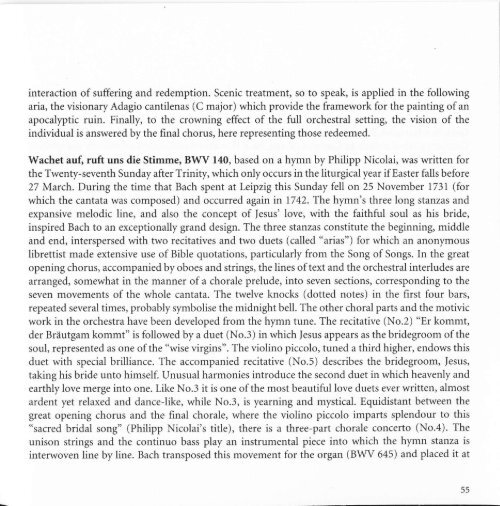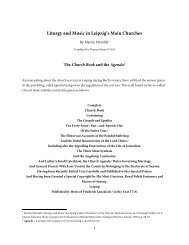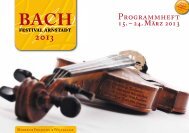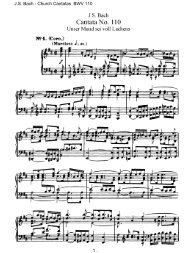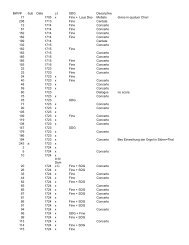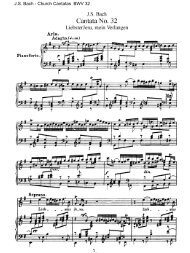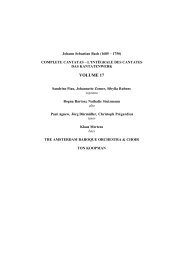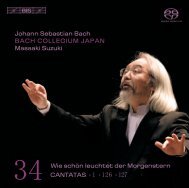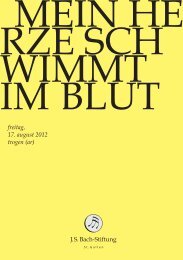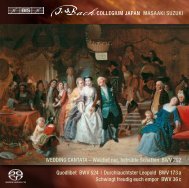Bach Cantatas, Vol. 2 - F. Werner (Erato 10-CD)
Bach Cantatas, Vol. 2 - F. Werner (Erato 10-CD)
Bach Cantatas, Vol. 2 - F. Werner (Erato 10-CD)
You also want an ePaper? Increase the reach of your titles
YUMPU automatically turns print PDFs into web optimized ePapers that Google loves.
interaction of suffering and redemption. Scenic treatment, so to speak, is applied in the following<br />
aria, the visionary Adagio cantilenas (C major) which provide the framework for the painting of an<br />
apocallptic ruin. Finally, to the crowning effect of the full orchestral setting, the vision of the<br />
individual is answered by the final chorus, here representing those redeemed.<br />
Wachet auf, ruft uns die Stimme, BWV 140, based on a hymn by Philipp Nicolai, was written for<br />
the Twenty-seventh Sunday after Trinity, which only occurs in the liturgical year if Easter falls before<br />
27 March. During the time that <strong>Bach</strong> spent at Leipzig this Sunday fell on 25 November l73L (for<br />
which the cantata was composed) and occurred again in L742.The hymn's three long stanzas and<br />
expansive melodic line, and also the concept of ]esus' love, with the faithful soul as his bride,<br />
inspired <strong>Bach</strong> to an exceptionally grand design. The three stanzas constitute the beginning, middle<br />
and end, interspersed with two recitatives and two duets (called "arias") for which an anonymous<br />
librettist made extensive use of Bible quotations, particularly from the Song of Songs. In the great<br />
opening chorus, accompanied by oboes and strings, the lines oftext and the orchestral interludes are<br />
arranged, somewhat in the manner of a chorale prelude, into seven sections, corresponding to the<br />
seven movements of the whole cantata. The twelve knocks (dotted notes) in the first four bars,<br />
repeated several times, probably symbolise the midnight bell. The other choral parts and the motivic<br />
work in the orchestra have been developed from the hyrnn tune. The recitative (No.2) "Er kommt,<br />
der Bräutgam kommt" is followed by a duet (No.3) in which ]esus appears as the bridegroom of the<br />
soul, represented as one of the "wise virgins". The violino piccolo, tuned a third higher, endows this<br />
duet with special brilliance. The accompanied recitative (No.5) describes the bridegroom, fesus,<br />
taking his bride unto himself. Unusual harmonies introduce the second duet in which heavenly and<br />
earthly love merge into one. Like No.3 it is one of the most beautiful love duets ever written, almost<br />
ardent yet relaxed and dance-like, while No.3, is yearning and mystical. Equidistant between the<br />
great opening chorus and the final chorale, where the violino piccolo imparts splendour to this<br />
"sacred bridal song" (Philipp Nicolai's title), there is a three-part chorale concerto (No.a). The<br />
unison strings and the continuo bass play an instrumental piece into which the hymn stanza is<br />
interwoven line by line. <strong>Bach</strong> transposed this movement for the organ (BrvW 645) and placed it at


